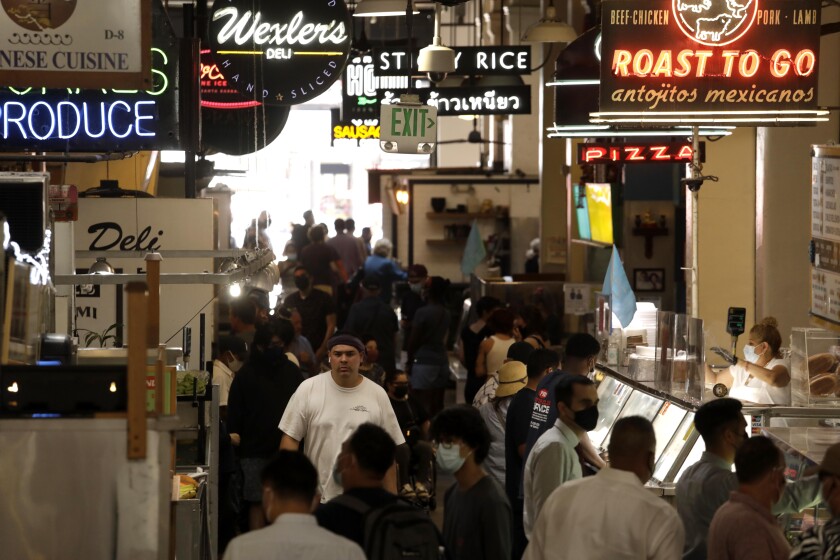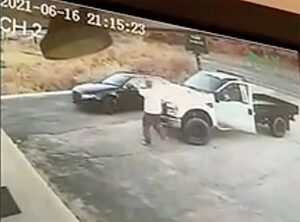The highly contagious Delta variant of the coronavirus is continuing to circulate in California, further highlighting the importance of getting vaccinated as the state and nation gear up to celebrate the Fourth of July, officials say.
President Biden previously set a goal of a dual-purpose holiday — “Let’s celebrate our independence as a nation, and our independence from this virus,” he said in early May — but the fireworks shows and backyard barbecues will instead be held amid the looming threat of Delta, which is perhaps twice as transmissible as the conventional coronavirus strains.
The good news, officials say, is that the available COVID-19 vaccines appear to offer strong protection against all circulating variants, including Delta. The bad news is that less than half of all Americans, and only about 50% of Californians, are fully vaccinated at this point.
“Any suffering or death from COVID-19 is tragic. With vaccines available across the country, the suffering and loss we are now seeing is nearly entirely avoidable,” said Dr. Rochelle Walensky, director of the U.S. Centers for Disease Control and Prevention.
A new coronavirus threat is prompting Los Angeles County health officials to request a voluntary rollback of one of the freedoms fully vaccinated people only recently began to enjoy: no masks indoors.
During a federal briefing Thursday, Walensky said that an estimated 25% of new coronavirus cases sequenced nationwide are now the Delta variant, and she expects it will eventually become the dominant strain in the country.
Also worrying is that approximately 1,000 U.S. counties, primarily in the Southeast and Midwest, have vaccination coverage of less than 30%.
“As the Delta variant continues to spread across the country, we expect to see increased transmission in these communities unless we can vaccinate more people now,” she said.
California, as a whole, measures up well in terms of COVID-19 inoculations — with nearly 41 million total doses administered, according to data compiled by The Times.
However, those shots have not gone into arms at equal rates across the state. In seven of California’s 58 counties, more than 60% of residents are fully vaccinated, while in 10 other counties, fewer than a third of residents can say the same, Times’ data show.
“The risk for COVID-19 exposure and infection will remain in California until we reach community immunity with vaccinations,” said Dr. Tomás Aragón, director of the California Department of Public Health and the state’s public health officer. “COVID-19 vaccines provide excellent protection from serious disease, even for the Delta variant.”
With the highly contagious Delta variant of the coronavirus continuing to spread statewide, the Los Angeles County Department of Public Health is recommending that all residents wear masks in public indoor spaces — regardless of whether they’ve been vaccinated for COVID-19.
Circulation of the variant — which was first identified in India and is also known as B.1.617.2 — has increased rapidly since it appeared in California.
Delta made up just 1.8% of coronavirus cases analyzed in April, state public health data show.
That proportion jumped to 4.7% in May. As of last week, the variant made up 14.5% of specimens sequenced during June.
On Tuesday, Aragón said the variant now accounts for about 23% of sampled cases, “and we anticipate this percentage will increase.”
Los Angeles County Public Health Director Barbara Ferrer said the Delta variant is also continuing to spread in L.A. County.
“The rising proportion of Delta among sequenced variants of concern is consistent with what other parts of the U.S. are seeing and for certain represents increased circulation of the variant,” she said Thursday.
The infectious potency of the Delta variant was one of the factors that prompted Los Angeles County this week to recommend that even vaccinated residents resume wearing face coverings in public indoor settings as a precaution.
The World Health Organization also says people should still “wear a mask, especially in crowded, closed and poorly ventilated settings,” even after they’ve been vaccinated.
However, the CDC continues to advise that those who are fully vaccinated don’t need to wear masks in most situations.
Dr. Anthony Fauci, the U.S. government’s top infectious disease expert, said Thursday that the broad recommendation remains, “If you are vaccinated you have a high degree of protection, so you need not wear a mask either indoors or outdoors.”
But, he added, local leaders have the flexibility to make recommendations based on the conditions in their communities.
COVID-19 vaccines appear to protect against the Delta variant, but there’s real concern about the vulnerability of people who aren’t yet vaccinated.
The circulation of the Delta variant locally is all the more concerning given that L.A. County is already tracking slight, but notable, upticks in its coronavirus metrics.
“Community transmission is still extraordinarily low in L.A. County,” Ferrer said this week. But, she added, “we have had increases across the board this past week.”
On June 15, California’s reopening day, the nation’s most-populous county recorded 210 new coronavirus cases, and the proportion of conducted tests coming back positive was hovering around 0.5%.
Both those metrics had doubled by Wednesday, with the county reporting 422 new cases and a test positivity rate of 1.2%.
The seven-day statewide positivity rate also effectively doubled over that same period, according to the California Department of Public Health.
Ferrer has previously said one factor that could be inflating the positivity rate is that schools have let out for the summer, which significantly shrank the number of people undergoing routine surveillance testing. That means the testing pool is not only shallower, but likely filled more predominantly with residents who are symptomatic or have been exposed to someone with COVID-19.
Over the past week, California has reported an average of 888 new coronavirus cases per day — virtually flat from two weeks ago, Times’ data show.
Even with the recent increase, officials were quick to note that L.A. County’s numbers remain well below the harrowing heights seen during the fall-and-winter surge. And, given the level of vaccine coverage, many experts believe a return to those dark days is unlikely.
But the surest way to stave off that possibility is to break the chain of transmission. Fewer new infections also means fewer opportunities for the coronavirus to mutate in potentially dangerous ways.
“I think we can all agree that it would take a lot of unforeseen events to get us back to where we were last year — and the biggest would be some new variant of concern that the vaccines don’t work against,” Ferrer said. “That would be a disastrous scenario for us, and an unlikely one.”




















